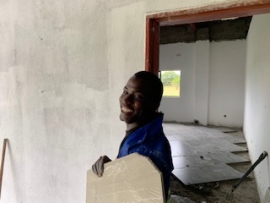The new school offers a home economics lab, science labs, a library and a new four-pillar car lift for the automotive department. Funding was also used to furnish the rooms with necessary items. The science lab has concrete workstations and a water system with taps and lab sinks, while the home economics lab was able to add a refrigerator and other items.
The Don Bosco Technical Secondary School has had a dramatic increase in the number of youth getting an education. Salesians report that previously there were an average of 47 students at the college each year. Enrollment is now up and 1,094 students are gaining their education — 432 students in the college and 662 students in the technical secondary education school. In December 2022, 100% of students passed their grade nine government exams, making Don Bosco Chingola the top school in the district out of 147 secondary schools.
Deborah Chibusha, a first-year student and the only female student in her automotive class, had a message for donors. She said, “I appreciate the good works you have done for me and many others here in Don Bosco Chingola. You have not just imparted me with a skill but also have changed my life and given it a new meaning. Honestly, I was struggling financially being a young mother of two children without a skill and dependent on a husband who is not supportive was a huge burden for me, but I thank God and you the Salesians who have helped to transform my life.”
Technical secondary education is particularly important in the Chingola district because it is a mining town rich with copper and other mining materials. It has one of the biggest open pit mines in Africa. However, after the mine changed hands and a new investor took over, the mine closed and left many people unemployed. This has greatly impacted the entire area and youth saw little hope for the future. Many dropped out of school and started exploring the mines illegally, which is dangerous and has caused a number of deaths. This illegal mining is increasing the rate of juvenile delinquency in the area. The new school is working to curb the rising crime and give youth new purpose.
Poverty is widespread in Zambia with 64% of the total population living below the poverty line. For those living in rural areas, the poverty rate rises to 80%, according to UNICEF. Over the past three decades, incomes in Zambia have fallen steadily, and people do not have enough money to meet basic needs such as shelter, nutritious food and medical care.
Source: Mission Newswire


